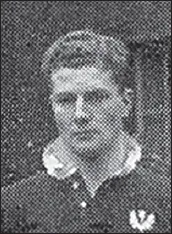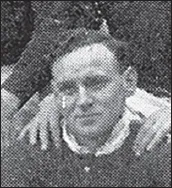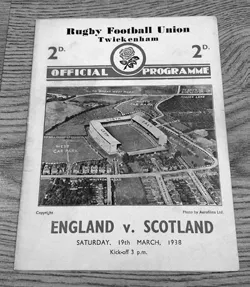![]()
Scotland
![]()
Pilot Officer Donald Mackenzie
Scotland
Two tests
603 Squadron RAF
Died 12 June 1940, aged 23
Number 8
First rugby international killed during the Second World War
Donald Kenneth Andrew Mackenzie was born on 30 November 1916 in China. He was the son of John, a customs officer in Shanghai, and Bertha. The family later returned to Edinburgh. Mackenzie was educated at the Inverness Academy where he trained to be an accountant. Mackenzie’s club side was Edinburgh Wanderers, where he developed quickly and came to the notice of the Scottish selectors. He was picked to play for Scotland twice, both caps coming during Scotland’s disastrous 1939 season. Scotland entered the season as Triple Crown champions, having beaten all three of their opponents in the 1938 Home Nations championship. The Grand Slam was not available as France had been banned from competing over allegations of professionalism. Scotland would lose all three of their 1939 games, ending bottom of the table as England, Wales and Ireland finished joint top with two victories each.
Mackenzie was brought in at No. 8 for the second match of the season, against Ireland, replacing the redoubtable Laurie Duff who had recently played two tests for the British Lions in South Africa. Scotland had lost the opener in Wales and were away again, finding themselves playing on a filthy day in Dublin. They had hoped to capitalise on their mesmeric backline, which had wreaked so much havoc in the Triple Crown season. They had put twenty-three points past Ireland that year, but the weather and a brilliant display from the Irish pack put pay to any hopes of a repeat. The Scots tried hard, having been accused of capitulating in the Welsh game, but simply could not compete with the ‘lusty forward rushes’ which typified the Irish play.
In its match report, The Scotsman was generous to Mackenzie, stating, ‘The new cap DKA Mackenzie also did well and was particularly prominent in the opening stages’ before adding the slightly cryptic note that ‘his fine height was not only useful but necessary.’
Mackenzie kept his place for the season’s final match, against England at Murrayfield. The match was another disappointment. A record crowd arrived at Murrayfield hoping for a repeat of the previous season’s victory at Twickenham where Wilson Shaw had inspired his team to a famous victory with two scintillating tries. The Scottish captain responded with his best performance of a mediocre season, crossing for one of his team’s two scores. However, whereas in 1938 the Scottish backs had been good enough to compensate for a badly beaten pack, there would be no such escape on this occasion. The Scottish forwards lost 48 scrums and 21 line outs, winning only 12 and 8 respectively, with The Scotsman opining that ‘seldom has an international pack been so outplayed.’ The English forwards were hardly stretched, dominating play even more comprehensively than the statistics suggest. The back row were singled out for special criticism, with The Scotsman writing ‘DKA Mackenzie was amongst the men who was hardly seen.’ The newspaper also reported how his back row colleague W.H. Crawford ‘suffered the unusual distinction of being told from the embankments what he ought to do.’
Given the inadequacy of both his individual performance and that of the team, Mackenzie may well not have played for Scotland again. The outbreak of war was to make that an academic question. Mackenzie was a member of the Auxiliary Air Force, a reserve of civilian pilots trained and ready to serve the country in time of conflict. In 1939 Pilot Officer Mackenzie and his squadron, 603 (City of Edinburgh) were transferred to the full-time RAF.
The squadron was strategically placed to defend Scotland’s industrial heartlands and the approaches to the great naval base at Scapa Flow. On 16 October 1939 the unit claimed the war’s first German victim over British soil, a Junkers 88 bomber.
603 Squadron was equipped with Spitfires, having been recently upgraded from Gloster Gladiator biplanes. Mackenzie was piloting Spitfire L1050 on a training flight on 12 June 1940 when it crashed during a night exercise near Balerno, eight miles south-west of Edinburgh. He was killed outright.
Mackenzie’s squadron flew south two months after his death to take part in the Battle of Britain. Helped by pilots such as ‘ace’ Brian Carvery and Richard Hillary, author of The Last Enemy, 603 would claim more German aircraft than any other squadron in the battle.
Mackenzie is commemorated in the Colinton Parish Churchyard, southern extension, section N, grave 14.
![]()
Pilot Officer Thomas Dorward
Scotland
Five tests
25 Squadron Royal Air Force Volunteer Reserve
Died 5 March 1941, aged 24
Scrum half
‘A really good scrum half’
Tom or ‘Tommy’ Dorward was born on 27 March 1916 in Galashiels, Scotland. He was the second son of the Galashiels textile manufacturer Adam Paterson and Isabella Fairgrieve Dorward of Galashiels. Along with his brothers Pat and Arthur, he attended Sedbergh School. Sedbergh sits in the sort of dramatic Cumbrian scenery to be expected of the school attended by William Wordsworth’s son. It has an educational approach which matches the rugged scenery and is epitomised in the school motto: A Stern Nurse of Men.
The school’s ethos clearly suited the Dorward brothers, with all three performing well academically and on the playing fields. Despite the often inclement weather – the school’s meteorological society doggedly recorded 80 inches of rain in 1928, with up to 3.5 inches falling in one day – cricket was a priority in the summer. Tom was described as being cheerful in fielding practice and, overall, ‘a very fair player, with a weakness for playing straight bowling to square leg’.
The major sport was, of course, rugby. The Dorward boys all played to a high level, with Arthur later joining Tom on the school’s impressive list of international players. Names such as John Spencer, Will Carling, Will Greenwood and James Simpson-Daniel will resonate with modern readers. At the time of Tom’s attendance, however, the name of William Wavell Wakefield stood head and shoulders above the others on the list.
Wakefield was a true polymath. His rugby career saw him win thirty-one caps and inspire England to back-to-back grand slams in 1923 and ’24. He is credited as being one of the game’s finest thinkers and strategists, and went on to become president of the RFU. Outside rugby he served with distinction in both the First and Second World Wars, was a long-standing Conservative politician, and found time to be influential in the development of both scuba diving and ski jumping.
Wakefield remained closely connected with the affairs of the school, regularly playing in Old Boys’ matches during Tom’s time. In a match just before Christmas 1933 Tom was playing for the school against the legendary flanker, the school journal gleefully recording the moment: ‘WW Wakefield successfully dummied half the side’.
Tom was quickly established as the scrum half for the first XV, and benefitted from the high standard of rugby played there. In 1933 he played in the annual fixture against Loretto School where he was in opposition to the winger W.N. Renwick. Renwick would go on to play alongside Dorward for Scotland in 1938 and was also destined to die in the war.
The Sedberghian praised Tom as a ‘really good scrum half’ and in 1935 wrote, ‘Dorward was outstanding, being very quick off the mark and armed with the most convincing dummy’ – it appears he was paying attention when playing against the great man!
Dorward’s partner at fly half was Rab Bruce Lockhart, a pairing that was to be recreated at national level in 1939. Bruce Lockhart was a scion of the Scottish sporting, teaching and spying family. Rab’s father, John, was Sedbergh’s headmaster and himself a dual cricket-rugby international. Rab’s brother Logie also played rugby for Scotland. John’s brother, Robert, was a noted footballer and worked for the British secret service while serving as unofficial ambassador to the Bolsheviks in 1917!
Tom left Sedbergh in 1935 and returned to the Borders where he became a fixture in the Gala side. He rapidly attracted the attention of the regional selectors and October of that year saw him facing the All Blacks in their tour match against the South of Scotland. The 1935 team was not quite the match of New Zealand’s two previous touring parties (the 1905 Originals and the 1924 Invincibles who between them had one – disputed – loss in seventy-two matches), but to the Borders public the All Blacks were still the All Blacks. 11,000 were at Hawick’s ground to see the game.
The match was very nearly a historic victory for the Scottish side. The occasion was noted for the ‘robust’ competition between the forwards and Tom will have had a good view of the shenanigans from his vantage point at scrum half. The Borderers refused to be intimidated, and indeed took the game to the All Blacks – bewildering the Kiwis with a fine dribbling display. The south were in the lead with ten minutes to go, but conceded late points and then missed a final penalty which would have given them a draw.
Clearly Tom could hold his own against the strongest competition. By 1937 he was in contention for the Scottish team. He was invited to play for F.J.C. Moffat’s invitation team in a specially arranged match against Watsonians, apparently to see how he fared against the home side’s equally promising scrum half. In the end neither player was able to oust the Scottish captain Ross Logan from his position in the side. Tom had to wait until 1938 for his debut.
The 1938 season was a famous one for Scotland. The Triple Crown was won for the eighth time in the nation’s history, a feat that would not be repeated for forty-six years. The achievement was no less sweet for being in some ways a notional one. In keeping with the strict amateur ethos of the time, the Home Nations championship was, officially, merely a series of friendly matches. A trophy for what had become the Six Nations championship did not arrive until 1993, and the Triple Crown had to wait until 2006. Scotland have yet (2017) to be awarded the physical trophy.
Dorward made his international debut against Wales at Murrayfield on 5 February 1938. Despite being 0-6 down at half time Scotland fought back hard, to finally take the game by the narrow margin of eight points to six, Wilf Crawford scoring all the points with a try, a conversion and a penalty. His next match was against Ireland, again at Murrayfield, on 26 February. Once again Scotland took the honours by twenty-three points to fourteen. Archibald Drummond scored one try and kicked a penalty, John Forrest got the ball down twice and Duncan Macrae managed a fourth try. Wilf Crawford kicked two conversions and Dorward got off his international mark by dropping a goal. Scotland’s final match of the season was against the old enemy England at Twickenham. The match was played on 19 March. Scotland played a brilliant game beating England by sixteen points to twenty-one. Charles Dick scored Scotland’s opening try, William Renwick grounded two further tries and Wilson Shaw two more. Wilf Crawford kicked two penalties. Scotland would only defeat England at Twickenha...




